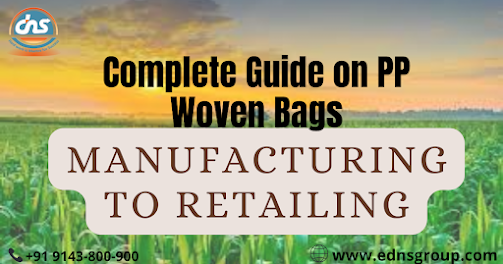Polypropylene woven bags are no more a strange name for people. You can see these bags almost everywhere. And because of its versatility, it has become one of the most popular packaging materials of the present time, having a wide industrial application. The PP woven bags offers lots of functionality and features, however, you would be amazed to know that these bags do not require many resources for manufacturing. The PP fabric is the simplest with the most advanced features. Furthermore, you would be surprised to know that manufacturing of this fabric is simple and requires the minimum resource. Here is the insight into its complete manufacturing process.
Read more: https://sites.google.com/view/woven-bags-manufacturers-guide/home
First Step - Manufacturing Of PP Woven Bags Sheet
The first step of
making PP woven fabric is melting
and turning polypropylene granules into thin films. After the film development,
the specified thickness of strips are cut from it. This strip act as a thread
in the polypropylene woven bags making process. The strips are cut according to
the woven fabric requirement. For low grade regular woven bags regular size
strips are cut. For thick fabric, its measurements are adjusted according to
requirements.
At this stage,
stabilizers, filters and other chemicals are added to the polypropylene mix. It
makes this mix ready for developing stable PP woven fabric which is printable,
dyeable and stretchable.
Second Step - Managing Polypropylene Thread
The thread derived
from the process is rolled over bobbins. The same bobbin is then used in the
weaving process. The thread from bobbins is woven in a weft and wrap manner to
create PP woven fabric. It is similar to the bobbin used in sewing machine. At
this step, the thickness of the woven fabric is customized according to the
requirement. Yes, PP woven fabric comes in different thickness and based
on that its value is decided.
Third Step - Managing PP Woven Fabric Roll
At this stage, the
pp woven fabric starts taking its final shape. The fabric is wrapped in a
circular way to form pp woven fabric
roll. It is then cut and sewed at one end to make PP woven
sacks/bags.
To make woven sack
from the fabric it is cut and sewed at one end. Sacks are the most prevalently
used packaging material in our country. You can see its use from field to bulk
food packaging. To make bags handles and other things are added to sacks
later.
The PP fabric roll
comes in different sizes and shapes depending on the bag's specifications,
e.g., for laminated bags, there will be a laminated pp fabric roll, for Bopp
bags, there will be a BOPP fabric roll. Similarly, for different sizes of bags
and sacks, a different set of the roll is there.
Printing On PP Bags
The PP woven bags manufacturer offers two
types of printing on PP bags. Regular printing like offset and screen, and the
second is BOPP film printing. BOPP is the most advanced form of printing on these
bags. In this printing format, a BOPP film is laminated over the PP woven bags.
It has a glossy finish and gives an attractive appearance to the bag.
Regular printing is mostly
used for adding packaging details to the bag. It is also used for products labeling.
In these bags, printing on fabric is also customizable. Printing is done after
the final bag has come in the shape.
Read
more: https://sites.google.com/view/pp-woven-bags-requirements/home
Exclusive Features
Of PP Woven Fabric and Its Products
The PP woven fabric
has some exclusive features that make it different from other packaging
materials. It includes
·
PP woven fabric is a highly customizable
material.
·
The fabric has a high resistance to wear and tear.
·
It is robust and has a high weight taking
capacity.
·
The fabric is non-reactive. Therefore, it is considered
one of the safest packaging materials for food preservation.
·
Polypropylene
woven bags are one of the lowest cost bags because of their
low manufacturing and raw material cost.
·
The fabric has good moisture resistance. The same
characteristic is visible in the polypropylene woven bags also.
How To Get PP woven
Bags
Several PP
woven bags manufacturers are present in
India, and they provide a wide range of products catering to different
packaging requirements. The manufacturers follow international standards and
use the finest quality products in bag manufacturing.
Conclusion: All these practices
have ended up any dependency on the export of polypropylene bags and made it
affordable. Further, the presence of a large number of manufacturers in India
has made availability of woven bags unhindered. Some of the manufacturers are
even into the export of pp woven fabric roll, bags, sacks and other product of
propylene to different countries.
Useful Topics as per your
interest

hi
ReplyDeleteBOPP Bags are designed to provide a reliable and visually appealing solution for packaging a wide range of products. Made from biaxially oriented polypropylene, these bags offer excellent strength, clarity, and resistance to moisture, making them ideal for food, retail, and industrial applications. Their lightweight construction reduces shipping costs while maintaining durability. Additionally, Bopp Bags Manufacturer in India can be customized with printing and branding options, enhancing product presentation. Combining efficiency, protection, and sustainability, these bags are a modern packaging choice for businesses seeking quality and performance.
ReplyDeleteLeno mesh bags are an excellent solution for carrying, storing, and organizing a wide range of products efficiently. Their breathable, open-weave design allows airflow, keeping contents fresh and reducing the risk of moisture accumulation. Despite their lightweight nature, Mesh Bag Manufacturer are strong enough to handle heavy loads, making them ideal for fruits, vegetables, and bulk items. The transparent mesh structure enables quick identification of items, enhancing convenience and workflow. Durable, reusable, and environmentally friendly, Leno mesh bags offer a practical and sustainable alternative to traditional packaging, combining functionality with reliability.
ReplyDelete